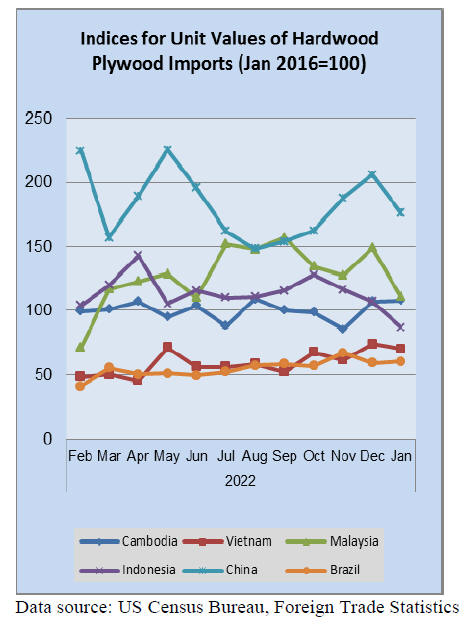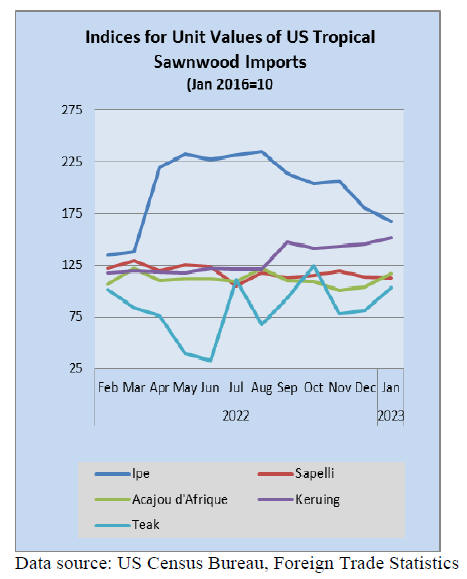|
Report from
North America
Housing starts rise for first time in six months
New home construction moved upward in February for the
first time in six months led by apartment buildings but it’s
unclear if the bounce translates into a recovery for the
housing market.
Construction on new homes rose 9.8% in February to a
seasonally adjusted rate of 1.45 million. Despite the gain
from the previous month the annual rate of total housing
starts fell 18.4% from the previous year.
The February increase was larger than what Wall Street
expected. Economists polled by the Wall Street Journal
expected housing starts to stay at a 1.31 million rate from
January’s initial estimate of 1.31 million.
The better-than-expected housing starts was due to a boom
in apartment construction and with the US facing a
housing deficit, the addition of multi-family units is likely
to boost affordability. The construction pace of singlefamily
homes rose 1% in February and apartments jumped
24%.
Regionally, construction of homes rose the most in the
Midwest (up 70%) and the West (up 17%). Single-family
home construction in the West led the jump with a 28.5%
increase. The Midwest and South regions reported a drop
in single-family construction.
In Canada, the seasonally adjusted annualised rate of
housing starts rose 15% to 243,959 units from a revised
216,514 units in January according to the Canadian
Mortgage and Housing Corporation (CMHC). Economists
had expected starts to rise to 220,000. Groundbreaking
increased on both multiple unit and single-family detached
urban homes.
See:
https://www.msn.com/en-us/money/realestate/u-s-housingstarts-rise-by-9-8-in-february-led-by-a-surge-in-apartmentconstruction/ar-AA18HOL0
and
https://www.cmhc-schl.gc.ca/en/professionals/housing-marketsdata-and-research/housing-data/data-tables/housing-marketdata/monthly-housing-starts-construction-data-tables
Existing home sales surge ending 12-months of
declines
Existing-home sales jumped 14.5% in February to a
seasonally adjusted annual rate of 4.58 million, according
to the National Association of Realtors.The spike snaps a
12-month slide and represents the largest monthly
percentage increase since July 2020 (+22.4%). Compared
to one year ago, however, sales retreated 22.6%.
"Conscious of changing mortgage rates, home buyers are
taking advantage of any rate declines," said NAR Chief
Economist Lawrence Yun. "Moreover, we're seeing
stronger sales gains in areas where home prices are
decreasing and the local economies are adding jobs."
Month-over-month sales rose in all four major U.S.
regions. All regions posted year-over-year declines.
Sales in the Northeast improved 4.0% from January to an
annual rate of 520,000 in February, down 25.7% from
February 2022. In the Midwest, existing-home sales grew
13.5% from the previous month to an annual rate of 1.09
million in February, declining 18.7% from one year ago.
Existing-home sales in the South rebounded 15.9% in
February from January to an annual rate of 2.11 million, a
21.3% decrease from the prior year. In the West, sales
rocketed 19.4% in February from the prior month to an
annual rate of 860,000, down 28.3% from the previous
year.
See:
https://www.nar.realtor/newsroom/existing-home-salessurged-14-5-in-february-ending-12-month-streak-of-declines
US hiring remained robust in March
Employers added 311,000 jobs in February, a slowdown
from the prior month’s blockbuster showing but a robust
gain that could lead the Federal Reserve to accelerate the
pace of interest rate hikes to fight inflation.
The unemployment rate rose from a 54-year low of 3.4%
to 3.6%, mostly because the labor force, which includes
people working and looking for jobs, swelled by 419,000,
the Labour Department said. Economists surveyed by
Bloomberg had forecast 225,000 job gains.
Construction employment grew by 24,000 in February in
line with the average monthly growth of 20,000 over the
prior 6 months. Employment showed little change over the
month in other major industries, including manufacturing.
See:
https://www.bls.gov/news.release/empsit.nr0.htm
March consumer sentiment fell but inflation
expectations improved
Consumers turned negative in March even as their
expectations for inflation improved according to the latest
monthly survey from the University of Michigan. The
university’s overall consumer sentiment index fell to 63.4
from 67 a month earlier, a 5.4% decline, while the
expectations index dipped to 61.5 from 64.7, a 6.1% drop.
The index is still 7% above a year ago. However,
expectations for inflation a year from now fell to 3.8%
from February’s 4.1%.
See:http://www.sca.isr.umich.edu/
Manufacturing sector still shrinking
Economic activity in the manufacturing sector contracted
in February for the fourth consecutive month following a
28-month period of growth say the nation's supply
executives in the latest Manufacturing ISM Report On
Business.
The ISM's manufacturing PMI edged up to 47.7 last month
from 47.4 in January. The small rise was the first in six
months. Any level below 50 denotes contraction in the
sector.
Only four industries, including transportation equipment
and electrical equipment, appliances and components,
reported growth last month. Paper products, textile mills,
furniture and related products were among the 14
reporting sectors contraction.
But the worst could be over for manufacturing. So-called
hard data on factory production was solid in January,
while business spending on equipment appeared to have
rebounded at the start of the first quarter. Comments from
some manufacturers in the ISM survey were supportive of
this thesis.
See:https://www.ismworld.org/supply-management-news-andreports/reports/ism-report-on-business/pmi/august/


|